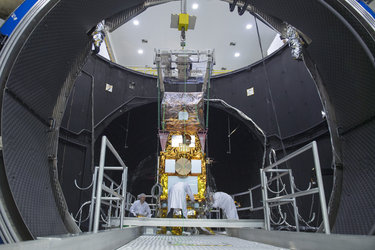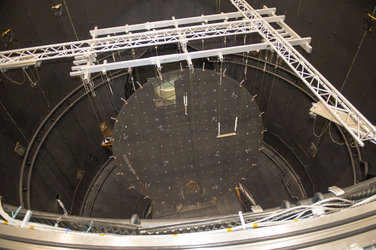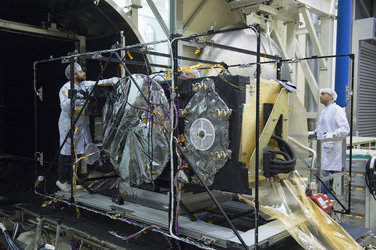Accept all cookies Accept only essential cookies See our Cookie Notice

About ESA
The European Space Agency (ESA) is Europe’s gateway to space. Its mission is to shape the development of Europe’s space capability and ensure that investment in space continues to deliver benefits to the citizens of Europe and the world.
Highlights
ESA - United space in Europe
This is ESA ESA facts Member States & Cooperating States Funding Director General Top management For Member State Delegations European vision European Space Policy ESA & EU Space Councils Responsibility & Sustainability Annual Report Calendar of meetings Corporate newsEstablishments & sites
ESA Headquarters ESA ESTEC ESA ESOC ESA ESRIN ESA EAC ESA ESAC Europe's Spaceport ESA ESEC ESA ECSAT Brussels Office Washington OfficeWorking with ESA
Business with ESA ESA Commercialisation Gateway Law at ESA Careers Cyber resilience at ESA IT at ESA Newsroom Partnerships Merchandising Licence Education Open Space Innovation Platform Integrity and Reporting Administrative Tribunal Health and SafetyMore about ESA
History ESA Historical Archives Exhibitions Publications Art & Culture ESA Merchandise Kids Diversity ESA Brand Centre ESA ChampionsLatest
Space in Member States
Find out more about space activities in our 23 Member States, and understand how ESA works together with their national agencies, institutions and organisations.
Science & Exploration
Exploring our Solar System and unlocking the secrets of the Universe
Go to topicAstronauts
Missions
Juice Euclid Webb Solar Orbiter BepiColombo Gaia ExoMars Cheops Exoplanet missions More missionsActivities
International Space Station Orion service module Gateway Concordia Caves & Pangaea BenefitsLatest
Space Safety
Protecting life and infrastructure on Earth and in orbit
Go to topicAsteroids
Asteroids and Planetary Defence Asteroid danger explained Flyeye telescope: asteroid detection Hera mission: asteroid deflection Near-Earth Object Coordination CentreSpace junk
About space debris Space debris by the numbers Space Environment Report In space refuelling, refurbishing and removingSafety from space
Clean Space ecodesign Zero Debris Technologies Space for Earth Supporting Sustainable DevelopmentLatest
Applications
Using space to benefit citizens and meet future challenges on Earth
Go to topicObserving the Earth
Observing the Earth Future EO Copernicus Meteorology Space for our climate Satellite missionsCommercialisation
ESA Commercialisation Gateway Open Space Innovation Platform Business Incubation ESA Space SolutionsLatest
Enabling & Support
Making space accessible and developing the technologies for the future
Go to topicBuilding missions
Space Engineering and Technology Test centre Laboratories Concurrent Design Facility Preparing for the future Shaping the Future Discovery and Preparation Advanced Concepts TeamSpace transportation
Space Transportation Ariane Vega Space Rider Future space transportation Boost! Europe's Spaceport Launches from Europe's Spaceport from 2012Latest

Sentinel-2B entering LSS
Thank you for liking
You have already liked this page, you can only like it once!
ESA’s Sentinel-2B Earth-observing satellite being lowered into Europe’s largest vacuum chamber, at the start of a test campaign to ensure it is ready to serve in space.
The satellite is now in ESA’s 15 m-diameter Large Space Simulator, where high-performance pumps will remove all air within the chamber to create an orbital-quality vacuum. Meanwhile, liquid nitrogen circulates through the black walls to mimic the cold of sunless space.
Sentinel-2B arrived by lorry on the night of 15 June, making the first time any of the Sentinel family of satellites serving the Copernicus initiative for global environmental monitoring has visited ESA’s technical heart, in Noordwijk, the Netherlands.
Sentinel travelled from Airbus Defence and Space’s Friedrichshafen facility in Germany, where it was first assembled and then all of its main elements underwent detailed testing.
Sentinel-2B is a twin of Sentinel-2A, launched a year ago. The two satellites together will provide global multispectral coverage, extracting valuable environmental data from the colours of land vegetation and coastal waters. They are equipped with laser communications to return data quickly to Earth.
The largest centre of its kind in Europe, ESA’s test facilities simulate every aspect of the space environment. Everything is housed under a single roof within a controlled cleanroom environment to avoid contaminating flight hardware.
A sequence of tests will be conducted on Sentinel-2B between now and the end of October.
The current thermal-vacuum testing will be followed by electromagnetic compatibility testing within the Maxwell chamber, to ensure the satellite can operate safely with its ground station – as well as with its launcher during its crucial first moments of life – without harmful interference.
Next, Sentinel will be blasted inside the Large European Acoustic Facility to simulate the extreme noise experienced atop the launcher during liftoff and its early climb to orbit.
A final set of performance tests will then check that all of its systems have survived exposure to these simulated mission environments.
-
CREDIT
ESA–G. Porter -
LICENCE
ESA Standard Licence














 Germany
Germany
 Austria
Austria
 Belgium
Belgium
 Denmark
Denmark
 Spain
Spain
 Estonia
Estonia
 Finland
Finland
 France
France
 Greece
Greece
 Hungary
Hungary
 Ireland
Ireland
 Italy
Italy
 Luxembourg
Luxembourg
 Norway
Norway
 The Netherlands
The Netherlands
 Poland
Poland
 Portugal
Portugal
 Czechia
Czechia
 Romania
Romania
 United Kingdom
United Kingdom
 Slovenia
Slovenia
 Sweden
Sweden
 Switzerland
Switzerland





























